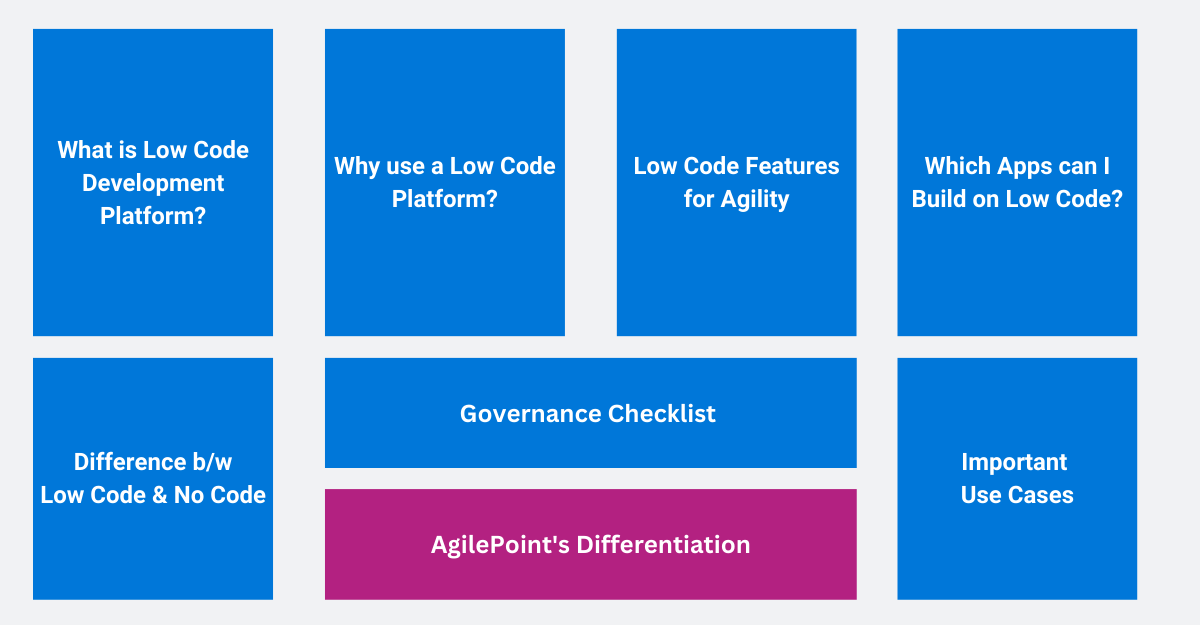
Low-code development platforms give application development capabilities to business users, citizen developers, and project managers. This article provides insights on low-code development platform, why teams use it, the difference between low-code and no-code, notable use cases, and governance considerations while using a low code platform in an enterprise.
What is a Low-Code Development Platform?
A low-code development platform (LCDP) provides a development environment to create application software through a graphical user interface. Users can visually build applications through a model-driven, drag-and-drop interface. Unlike the traditional software development approach that involves selecting a programming language, frameworks, package repositories, and integrated development environments (IDEs), a low-code development platform abstracts these components. It enables app development through drag-and-drop application components, pre-built integrations, and native mobile or web apps with minimal coding.
According to a leading consulting firm McKinsey, a low-code approach to app development saves up to 90% of development time.
Difference between low-code development and traditional software development
Low-Code Development
- Visual canvas-based
- Model-driven
- Business-user/End-user friendly
- Reusable components
- Out-of-the-box integration with 3rd party cloud systems/services
- Native collaboration and SDLC tools
Traditional Software Development
- Text-based (loops, functions, arrays, objects)
- Code-driven
- Professional software developer oriented
- Microservices
- API- or Code-based integrations developed by the IT department
- Leverages CI/CD tools managed by IT
Unlike a traditional (and highly scalable) programming environment only usable by professional software developers, a low-code platform enables rapid application development that may be used by multiple user groups, including:
- Citizen developers
- Business analysts (and process analysts)
- Project managers (and program managers)
- Professional and Line-of-Business developers
Why do enterprises use a Low-Code development platform instead of the traditional software development approach? The answer lies in three factors; speed and cost of development and innovation capability offered by the low-code development paradigm. However, it depends on the organizational context or the digital initiative as to what you may build using a low-code platform.
Why Enterprises need a Low-Code Development Platform?
Low-code development platforms help address strategic needs, including custom application development, business process automation, legacy modernization, rapid prototyping of new solutions, and digital transformation.
Business Process Automation
Low-code development platforms provide a way for business users to automate processes by applying business logic without the need for any programming knowledge. These platforms often come with Lego-like digital tools (like form-builder, user-friendly design canvas, process-manager, drag-and-drop controls, workflow builders, and advanced business logic) that make it easy to build and deploy applications to automate long-running business processes.
It helps reduce the time and cost associated with automation and makes it more accessible to a broader range of users. Additionally, low-code platforms can often be integrated with other business systems and data sources, creating more comprehensive and seamless automation solutions.
Custom Apps
Low-code development platforms are also used to build custom apps. These are software applications for users in an organization to fulfill specific business needs. The platform allows choosing pre-built templates or creating a new blank app. Users can leverage the drag-and-drop interface and other tools to design and customize multiple types of apps, such as static or dynamic applications, single-page applications, and progressive web applications. Another way to view custom apps is whether it is a single-use case departmental app or a cross-functional application. The low-code development platform may be preferred for custom app development because it lets you conveniently add and configure forms, use databases, integrate with 3rd party systems, and use workflow rules.
Cloud and Mobile Apps
The rise of mobile and cloud apps reflects the increasing shift towards digital and mobile-first business models. A modern low-code development platform allows business users to develop, test, deploy and maintain mobile applications for all operating systems, browsers, and devices in one platform. For instance, AgilePoint NX Mobile App Accelerator includes a low-code app development platform that enables users to create custom-branded native enterprise mobile applications for iOS, Android, or Windows devices without writing any code. They can then deliver their apps to business users within a few minutes, and the capability eliminates the need to hire mobile developers. Similarly, the platform enables you can create LOB apps spanning multiple systems using drag-and-drop tools. Low-code development platforms also help replace custom coding with model-driven development, drag-and-drop tooling, and reuse of services and app components.
Model Driven Development
Model-driven development (MDD) is a software development approach that focuses on creating and manipulating models of the desired software system rather than directly writing code. Model-driven development platforms shift the focus of software development activity from coding to modeling. Modeling, by definition, deals with higher-level changes in the application as a state machine instead of tactical coding manipulations. Unlike traditional Low Code platforms that generate code under the hood and thus result in the need to regenerate and redeploy the application, modern and model-driven platform architecture (as is the case with AgilePoint) allows business users and IT teams to make changes in the meta-data of the application model. The low-code platform’s run-time environment dynamically interprets and presents the application to its consumers.
Enable Business and IT Alignment
"The current software development paradigm is based on the divide between business and IT. Business users explain the requirements to developers who then translate these requirements into code, often resulting in communication degradation", says Jesse Shiah, Co-founder, and CEO of AgilePoint. One of the promising aspects of low-code development platforms is business and IT alignment. It is achieved through Involvement of IT in application development processes so that it can provide input on the technological implications of governance options, solution development, and maintenance. The alignment is also achieved by establishing a governance structure. This could include regular meetings between business and IT leaders, as well as the establishment of a steering committee or other mechanism for coordinating efforts and ensuring compliance.
Low-Code Development Features that Provide Agility
Drag and Drop Tools
The drag-and-drop features of low-code platforms can help to simplify the process of building and customizing software applications, making it faster and easier for a wider range of users to create the solutions they need. These features typically involve using a visual interface to drag and drop pre-defined blocks or elements, such as forms, databases, and workflow rules, into the desired location within the application.
Reusable Services and Components
Reusable services and components are pre-built pieces of functionality that can be used as building blocks for creating software applications. Reusable services may include pre-built integrations with other systems or data sources, authentication and authorization functions, UI components, forms, and common capabilities that are needed by many different types of applications.
What type of applications can I develop using an enterprise Low-Code development platform?
You can use low-code development platforms to build multiple types of applications. From an AgilePoint standpoint, you can build apps including:
· Enterprise, mission-critical, and cross-functional BPM and automation applications
· Hybrid apps combining digital process automation with RPA integration, e.g., UI-Path or Automation Anywhere
· Departmental and collaborative workflow apps
· Forms-based, cross-channel, digital application experiences without workflow
· Business applications can run on mobile devices, tablets, or computers – whichever is best for the target audience.
Another factor determining the type of apps you can develop is whether you use a Low-Code or No-Code development platform. Below we capture a few key differences between a Low Code and No Code platform.
Difference between Low-Code and No-Code Development Platforms?
A critical difference between low-code and no-code platforms is the level of customization and control. Low-code platforms allow users to customize applications, while no-code platforms generally do not offer this option. No-code platforms are suitable for users looking to build simple applications quickly but may not be as ideal for more complex projects requiring more customization.
Another way to think is that a no-code platform is easier to use compared to a low-code development platform. However, the former is more restrictive and can only support single-use case apps. To sum up, consider the following factors when deciding between a no-code or low-code development platform.
- Extensibility: It is difficult or sometimes impossible to extend your No-code by integrating it with legacy systems. No-code platforms are suitable for single-purpose use cases where cross-functional automation is not a huge requirement.
- Governance: Low-Code platforms provide better and more elaborate governance and compliance tools within the platform.
- Deployment: Low-code platforms offer more deployment options for large companies or companies requiring regulatory compliance baked into their apps (think on-premises, hybrid-cloud, and private cloud). On the contrary, it is challenging to use no-code platforms except through vendor-offered SaaS models.
- User Experience: You can customize the user experience (UX) of modern Low code development, whereas it is not conveniently possible to do so in a no-code environment.
Below we summarize the essential use cases of a Low Code development platform.
Important Use Cases of Low-Code Development Platforms
Low-code development platforms can be helpful in various situations where the need for custom software arises.
Fig 1- Low Code Development Use Cases
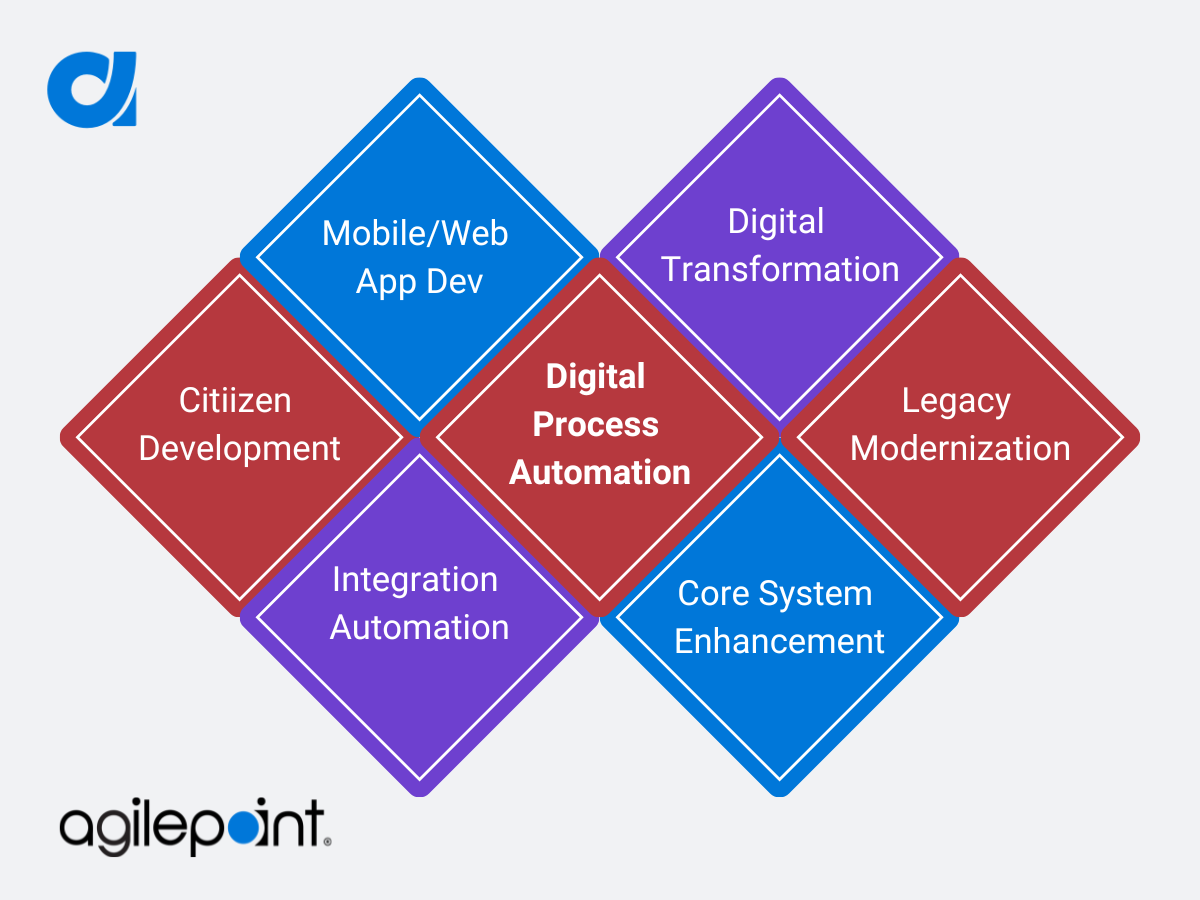
- Process Automation: An organization operates on processes, from new product development and Order-to-cash to supply chain management. Low-code platforms have their roots in BPM technology; hence, they help automate long-running processes.
- Legacy modernization: Low-code development platforms are also used to update or replace outdated systems and technologies. AgilePoint customers use our Low-code development environment to build new applications that integrate with and eventually replace legacy apps. Example: Migrating legacy apps developed in SharePoint and Lotus Notes. In other cases, customers use AgilePoint to build custom enhancements or integrations that can improve the functionality of legacy systems without requiring a full-scale replacement.
- Core System Enhancements: Another vital use case of the low-code development platform is core system enhancements. For instance, customers use AgilePoint's Low code platform for Anaplan workflows, a market-leading financial planning software. Other customers extend their ERP apps built in SAP, NetSuite, or Dynamics 365.
- Citizen development: Low-code platforms enable non-technical business users or "citizen developers" to build custom applications, freeing up IT resources to focus on core applications, maintenance of IT infrastructure, and cyber security.
- New application development: Even if you do not set up a dedicated 'Citizen Development' team in your organization, IT can use low-code development platforms to build new apps with a heavy process focus. Professional developers use Low code to extend their homegrown or vendor systems through open APIs, OOTB integrations, and custom coding.
- Digital transformation: Low-code platforms can be used to rapidly build and deploy applications that support digital transformation initiatives, such as the creation of mobile apps or the development of new customer-facing and partner/vendor management systems.
- Integration automation: You can use low-code platforms to build custom integrations and automate business processes, improving efficiency and reducing the need for manual coding of integrations.
We have established common use cases and applications you can build using low-code development platform. A key consideration should be to make these apps sustainable, manageable, and long-lasting. Hence, governance of low-code apps plays a crucial role.
Checklist to Ensure Governance of Low-code Development Platform
It is essential to ensure that low-code development does not turn into unmanageable sprawl. Therefore, IT should handle the governance of the platform and apps built on it throughout the application development lifecycle.
It requires low-code/no-code solution to provide layered and granular control over security and governance.
Below is a checklist to establish a governance framework for your low-code application program.
- Select a governance-oriented Low code development platform
- Establish policies and procedures (access control, data security, change management)
- Assign roles and responsibilities (for ideation, development, testing & deployment, maintenance, and app retirement)
- Determine Process Steps (for ongoing low-code app development)
- Establish a governance committee
- IT personnel, Business analysts or subject matter experts, Project managers, Executive stakeholders/sponsors, External consultants, Legal or compliance personnel)
- Implement security measures
- Monitor usage and performance
- Tracking platform usage metrics
- Regularly reviewing logs, reports, and Analytics Dashboard
- Monitoring application performance
Fig 2- Low-Code Development Platform Governance
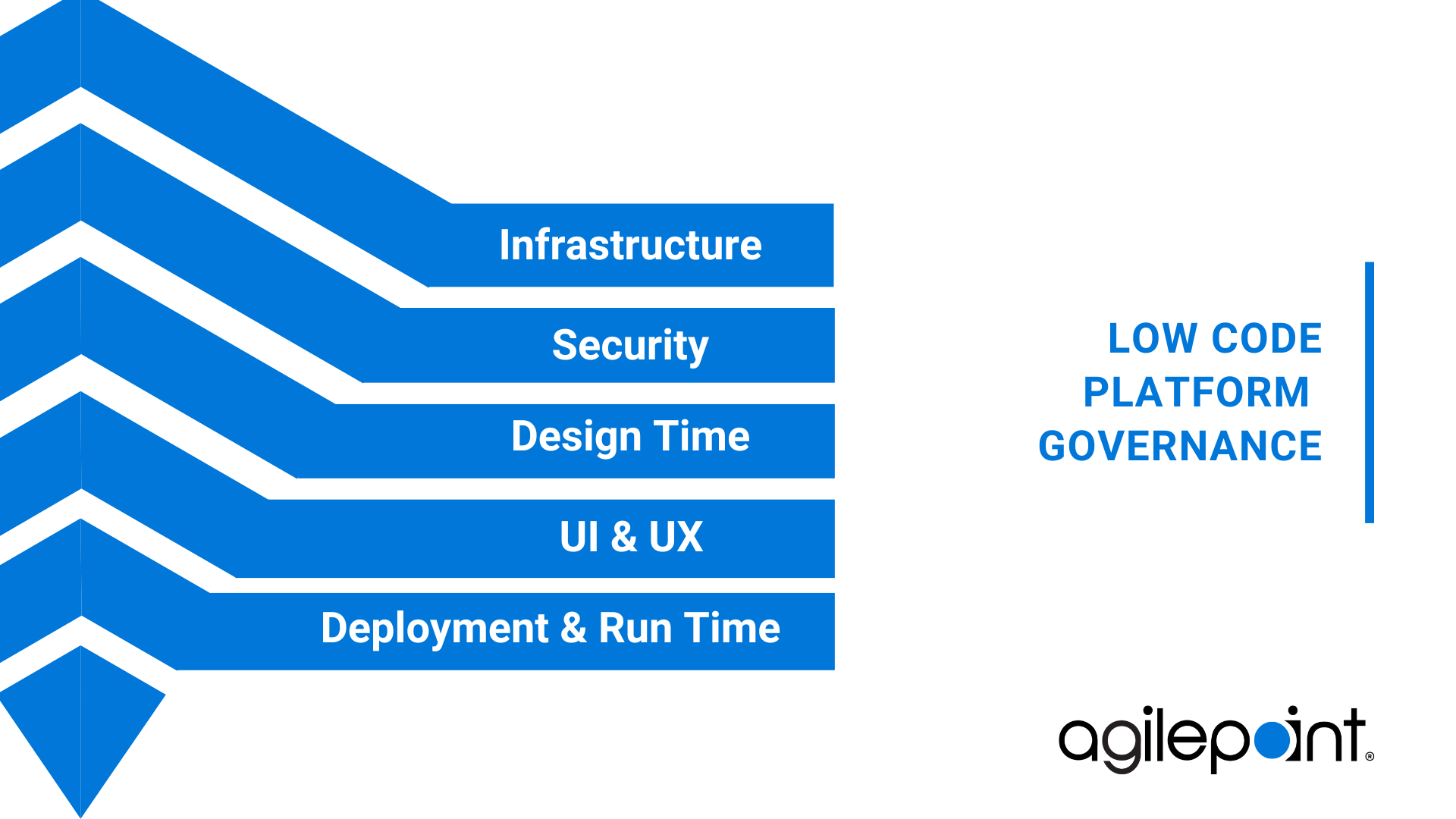
You may refer to this link to learn how granular security and governance capabilities can help in rapid solution development. Having learned a lot about why to use a low-code platform and how to ensure the sustainability of low-code apps, below are some business benefits of using these platforms.
Benefits of using a Low-Code Development Platform
Low-code development platforms provide several benefits that can help businesses. However, reaping these benefits is a journey, not a destination and a team keeps getting better at implementing complex use cases as its low-code development processes mature over time.
Fig 2- Benefits of Low-Code Development Platform

- Cross-functional process automation: Core processes are spread across functions; hence any serious automation initiative has to automate processes across multiple departments. Low-code platforms help achieve cross-function automation at a fraction of the cost and effort compared to traditional software development.
- Reduced development time: Reduced development time: Low-code platforms provide pre-built templates and drag-and-drop interfaces, making it easy to build complex applications without writing code from scratch. It can significantly reduce the time it takes to create new applications.
- Increased productivity: Low-code platforms allow non-technical users to build applications, freeing up IT resources to focus on more complex tasks. It improves overall productivity within the organization.
- Improved agility: A key requirement to sustain a rapidly changing business environment demands that IT solutions enhance agility instead of stifling it. Low-code platforms allow businesses to build and deploy applications quickly, making them well-suited for rapid iteration and solution development. It can help organizations respond quickly to changing business needs.
- Enhanced collaboration: Low-code platforms often bake in collaboration and project management tools helping business and IT teams to work together more effectively. It results in an improvement in communication and coordination within the development, testing, and deployment process.
The AgilePoint BPM and Low-Code Development Platform
AgilePoint is a business process management (BPM) centric low-code development platform that resembles other BPM platforms in some ways. However, five platform capabilities make it unique and different from traditional business process management software and low-code platforms.
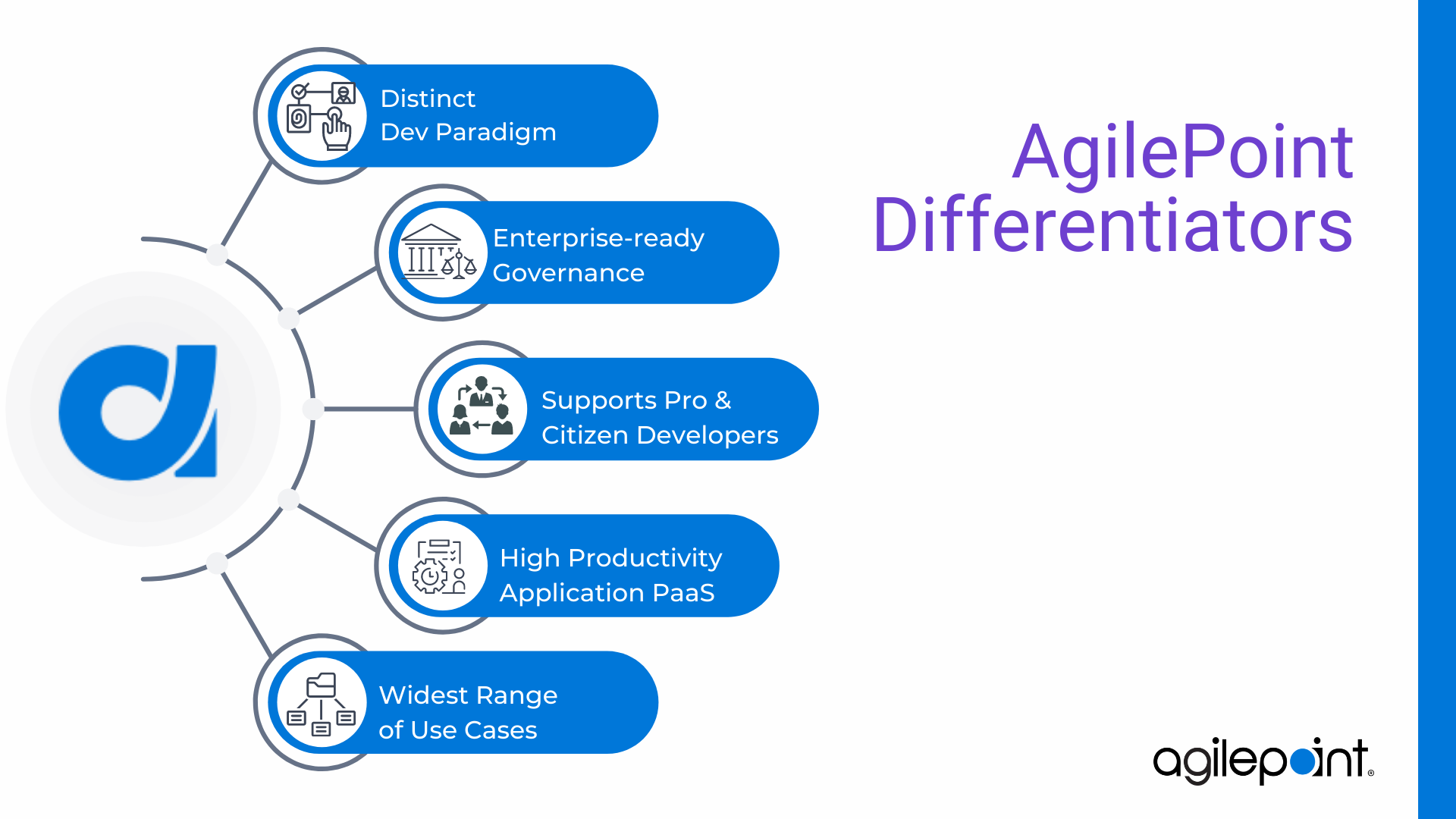
Distinct Development Paradigm
AgilePoint’s low-code development paradigm differs from competing platforms because the platform does not generate code. Instead, the AgilePoint platform generates meta-data, which is much simpler and more convenient to change than compiled code. For instance, one of the critical use cases of AgilePoint is building process-driven applications.
The AgilePoint BPMS engine executes processes on the fly based on XML metadata in the process definition, and this eliminates the need to write or compile code.
The ability for processes to be controlled on the fly and migrated to new versions allows for rapid adaptation to unforeseen circumstances.
In other BPM systems, continuous application improvement is not possible. Processes require compiled code, so it is typically necessary to stop and restart a process at some point during the lifecycle. With AgilePoint, process instances can be started, stopped, rolled forward or backward, or migrated to new or old versions on the fly without interrupting the process flow. Hence, application behavior is typically managed by a business analyst, with no intervention required from IT.
“Unlike many tools that leverage code generation to create applications, we must look for Low-Code solutions based on an abstraction framework and model-driven architecture,” says Jesse Shiah, Cofounder and CEO, AgilePoint. "In this case, it preserves the application or process as a model from design to execution. When you want to come back to improve, you will still be working on the model. It is the only way to scale Citizen Development in an organization, especially in a large enterprise”.
Addresses the widest range of use cases
One of the core differentiators of AgilePoint is that it addresses the broadest range of use cases. It has helped our customers to avoid using multiple low-code platforms, one for spreadsheets, another for mobile, another for database, and yet another for forms. A visual representation is as follows.
Fig: Spectrum of Use cases for Enterprise Low-Code No-Code Platform
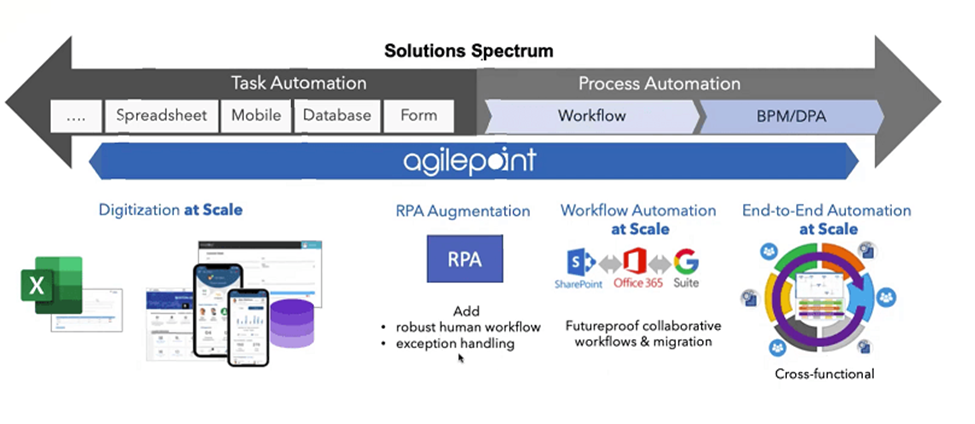
Fig- Types of Apps

High Productivity Application Dev Platform
AgilePoint is a High Productivity Application Platform as a Service (HpaPaaS). Gartner coined the term HpaPaaS, and such platforms serve several purposes, including:
Platform-as-a-service to build enterprise apps
- Mobile and multi-channel support
- Data and process modeling
- Citizen development
- SDLC automation
- Collaboration
AgilePoint supports a subscription model with multi-tenancy and resource-sharing features. The platform enables the deployment of apps across various OS platforms with the same code, eliminating the need to write mobile-OS-specific code. AgilePoint is also used to manage data modules, documents, and business processes. With the modern trend towards Citizen Development, AgilePoint supports drag-and-drop features and model-driven development to simplify the development process further. Lastly, a key component of AgilePoint is it helps SDLC automation and collaboration to reduce the IT and business divide.
Activates Pro-Developers and Citizen Developers
AgilePoint BPMS redefines many traditional application development boundaries by changing the 'how to' and 'who can' leverage IT assets to create and continually improve end-to-end business process automation, integration, and dynamic process-driven applications. By utilizing AgilePoint BPMS, business users can leverage abstracted IT assets in the form of process-enabled services (i.e., in their familiar process language) and quickly assemble and further configure them on demand to create a directly executable process model.
For complex use cases (that span across subsidiaries and partner systems), the AgilePoint low-code layer allows professional developers to extend the library of no-code features and maintain complete control over solutions. To support SDLC, experienced developers can manage multiple sprints of the projects or any enhancement to a project (including when the sprint has completed its development cycle).
Governance and Compliance Tooling
For any LCDP, strong governance capabilities are critical, given that users are often spread across an organization. AgilePoint’s Low Code development platform supports highly regulated industries like manufacturing, financial services, and defense; hence it is natural to provide a layered governance model for apps built on the AgilePoint platform.
Your IT department can control and manipulate AgilePoint apps on three levels:
· Business layer: the UI layer where users perform routine tasks
· Process Layer: where process execution takes place
· Data Layer: where business data resides
These three layers can be deployed, accessed, and managed independently.
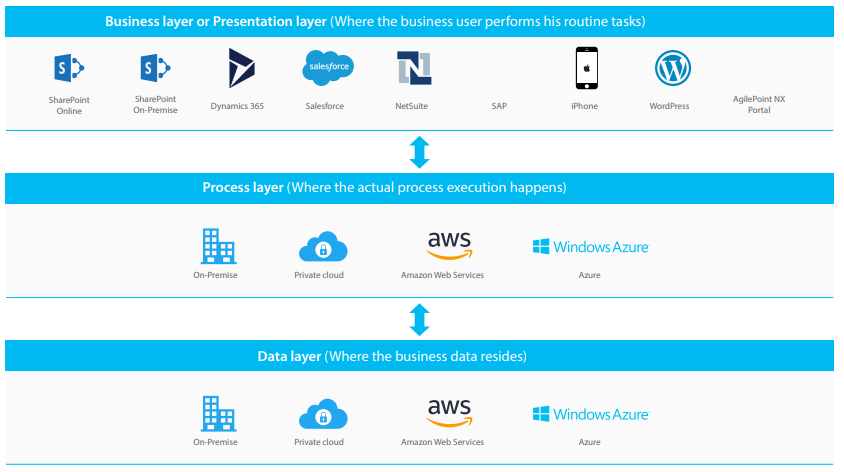
Another way to view AgilePoint’s governance capabilities is that the platform allows IT granular access controls and rights management for all the features at three levels:
· Overall system level
· Individual tenant level
· Individual app level
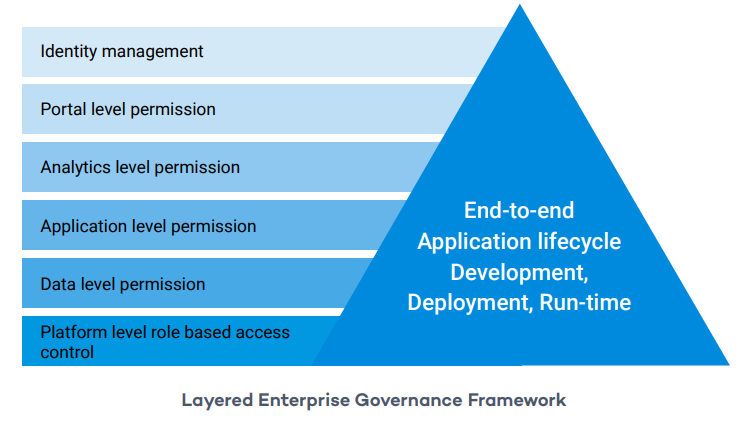
We have covered a lot about what a low-code development platform is, how it works, critical differences between low-code and no-code platforms, essential use cases, and governance of these platforms. However, the best learning occurs by doing.
Try AgilePoint free for 30 days to learn how it can benefit your team’s automation needs, or request a
Demo to have someone from AgilePoint shorten your learning curve.
Learn more:
Are you ready to reengineer your business
automation processes?

A modern process automation and orchestration platform that enables you to open up and seize new business opportunities, supercharge innovation, unlock new levels of efficiency and productivity, and deliver the experiences that help you win.
Follow Us
Platform

Automate business processes and workflows at scale. AgilePoint helps enterprises democratize and accelerate digital transformation, reduce technical debt and future-proof ROI.
Resources
© 2023 AgilePoint. All rights reserved.



